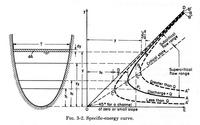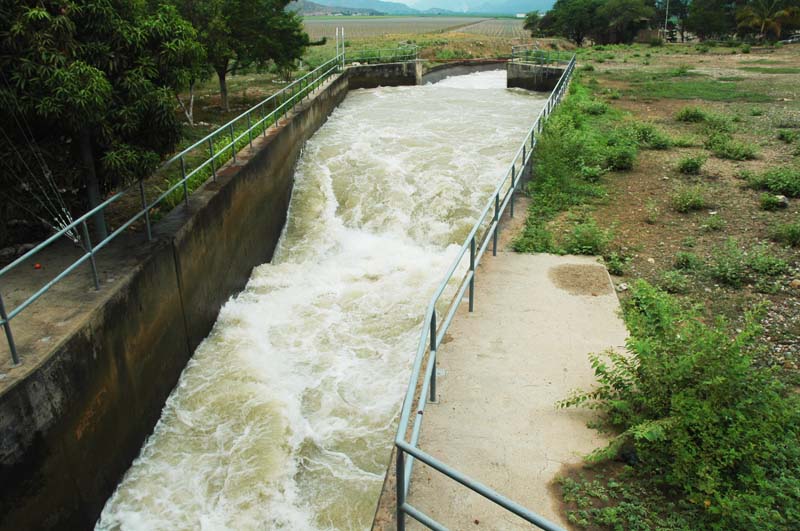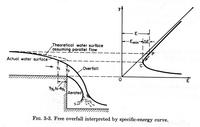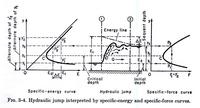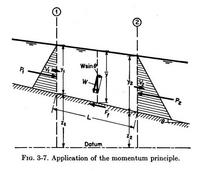|
H = zA + dA cos θ + αVA2/(2g)
H = z + d cos θ + αV2/(2g)
z1 + y1 + α1V12/(2g) =
z2 + y2 + α2V22/(2g) + hf
z1 + y1 + V12/(2g) =
z2 + y2 + V22/(2g) = constant
Se = hf/L
Sf = hf'/L
Sf = Se = So = Sw
E = d cos θ + αV2/(2g)
E = y + V2/(2g)
E = y + Q2/(2gA2)
E = y + Q2/[2g f2(y)]
E = f3(y)
E = y + Q2/(2gA2)
dE/dy = 1 - [Q2/(gA3)] (dA/dy) = 0
dA = T dy
dA/dy = T
(Q2 T) / (gA3) = 1
V2/(gA/T) = 1
V2/(gD) = 1
V2/(gD) = 1
F = V/(gD)1/2
F = 1
V2/(gD) = 1
V2/(2g) = D/2
αV2/(2g) = D/2
α V2/(2g) = (D cosθ)/2
F = V / [(gDcosθ)/α]1/2
yc = 1.4 yo
where yo is the depth at the brink.
Example 3-1. Channel contraction with and without gradual hydraulic drop.
Discharge = 100 cfs.
Upstream flow depth = 5 ft.
Upstream channel width = 10 ft.
Downstream channel width = 8 ft.
Length of the contraction = 50 ft.
Assume the floor of the contraction is horizontal and the friction through the contraction is negligible.
Determine the water surface profile in the contraction: (A) without gradual
hydraulic drop, and (B) with gradual hydraulic drop.
A. The specific energy in the upstream cross section is:
E = y + Q2/(2gA2) = 5 + 1002/[2g(10×5)2] =
5.062 ft
The velocity head upstream of the contraction is: 5.062 - 5 = 0.062 ft.
The specific energy at any section in the contraction is: E = 5.062 ft.
5.062 = y + 1002/[2g(by)2]
y3 - 5.062 y2 + (155.25/b2)
For b = 10 ft (upstream section):
y1 = 0.589 ft (low stage; alternate depth)
y2 = 5.000 ft (high stage; actual subcritical flow depth)
For b = 8 ft (downstream section):
y1 = 0.750 ft (low stage, with a drop)
y2 = 4.964 ft (high stage, without a drop)
For a contraction without a gradual hydraulic drop,
the high stages for intermediate sections are computed with the cubic equation.
B. When a gradual hydraulic drop is desired, the downstream flow depth should be at the low flow stage.
Narrow the width in the contraction to force a critical flow condition.
At the point of inflection, the flow is critical.
The critical flow depth is:
yc = (2/3) E = (2/3) (5.062) = 3.375 ft
The critical velocity is:
Vc = (g yc)1/2 = (32.17 × 3.375)1/2 = 10.42 fps
The width of the critical section is:
bc = Q/(Vcyc) = 100/(10.42 × 3.375)
= 2.844 ft
The side walls can be drawn as straight lines.
The low and high stages are computed by the cubic equation.
The calculated flow profile is based on the theory of parallel flow.
The flow near the drop is actually curvilinear, and the actual profile would deviate from the
theoretical one.
Since at critical flow, the velocity head is one-half of the flow depth:
Vc2/(2g) = yc/2
Q2/(2gAc2) = yc/2
Q2/(2gbc2yc2) = yc/2
yc = [Q2/(gbc2)]1/3
yc = (q2/g)1/3
Thus, in a rectangular channel, the critical flow depth is a function only of the unit-width discharge.
ONLINE APPLICATION:
With Q = 100 cfs, b1 = 10 ft, and y1= 5 ft, use onlinechannel17.php
to find bc = ?
E = ∫ Fdx
M = ∫ Fdt
E = (1/2) mV2
M = mV
Mass flux = ρQ
F = ρQV
F = βρQV
ρQ (β2V2 - β1V1) = P1 - P2 + Wsinθ - Ff
P1 = (1/2) γy1 (y1 b) = (1/2) γby12
P2 = (1/2) γy2 (y2 b) = (1/2) γby22
Ff = γ (hf'/L) bYL = γ hf' bY
in which hf' is the friction head loss, and Y = (1/2) (y1 + y2) (the average flow depth).
Q = (1/2) (V1 + V2) bY
W = γbYL
sinθ = (z1 - z2)/L
W sinθ = γbY(z1 - z2)
z1 + y1 + β1V12/(2g) =
z2 + y2 + β2V22/(2g) + hf'
ρQ (V2 - V1) = P1 - P2
P1 = γ z1_barA1
P2 = γ z2_barA2
where z1__bar and z2__bar are the distances from the water surface to the centroid of the area,
at cross sections 1 and 2, respectively.
V1 = Q/A1
V2 = Q/A2
ρQ (Q/A2 - Q/A1) = γ z1_barA1 - γ z2_barA2
[Q2/(gA1)] + z1_barA1 = [Q2/(gA2)] + z2_barA2 = constant
[Q2/(gA)] + z_barA = constant
F = [Q2/(gA)] + z_barA
dF/dy = - [Q2/(gA2)] dA/dy + d(z_barA)/dy = 0
d(z_barA) = [A (z_bar + dy) + T dy (dy/2)] - z_barA
d(z_barA) = A dy
d(z_barA)/dy = A
T = dA/dy
- [Q2/(gA2)]T + A = 0
[(Q2T)/(gA3)] = 1
(V2T)/(gA) = 1
F2 = 1
F = 1
F = [Q2/(gA)] + z_barA = constant
(q2b2)/(gby) + (y/2)yb = constant
q2/(gy) + (1/2)y2 = constant
(v2y)/g + (1/2)y2 = constant
F = γ [Q2/(gA)] + γ z_barA = constant
γ (q2b2)/(gby) + γ (y/2)yb = constant
γ q2/(gy) + (1/2) γ y2 = constant
γ (v2y)/g + (1/2) γ y2 = constant
|

